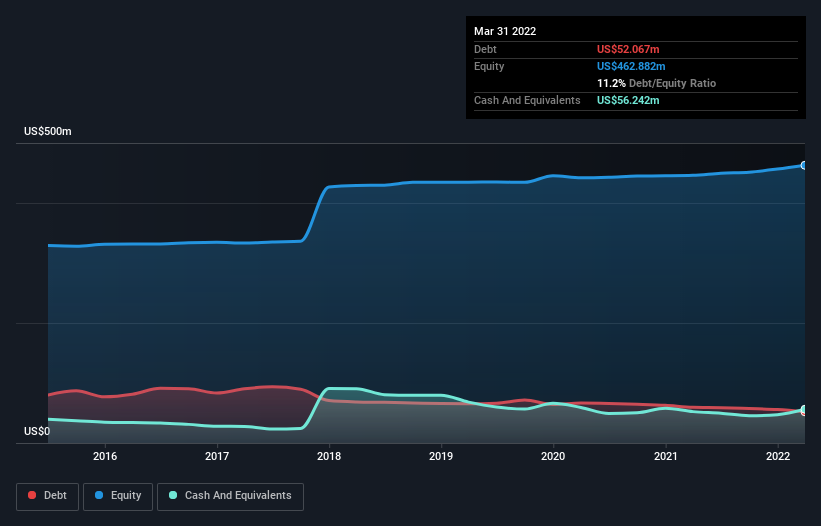Tejon Ranch (NYSE:TRC) Seems To Use Debt Quite Sensibly
David Iben put it well when he said, 'Volatility is not a risk we care about. What we care about is avoiding the permanent loss of capital.' When we think about how risky a company is, we always like to look at its use of debt, since debt overload can lead to ruin. We can see that Tejon Ranch Co. (NYSE:TRC) does use debt in its business. But is this debt a concern to shareholders?
When Is Debt Dangerous?
Debt assists a business until the business has trouble paying it off, either with new capital or with free cash flow. Ultimately, if the company can't fulfill its legal obligations to repay debt, shareholders could walk away with nothing. While that is not too common, we often do see indebted companies permanently diluting shareholders because lenders force them to raise capital at a distressed price. Of course, debt can be an important tool in businesses, particularly capital heavy businesses. When we examine debt levels, we first consider both cash and debt levels, together.
Check out our latest analysis for Tejon Ranch
How Much Debt Does Tejon Ranch Carry?
You can click the graphic below for the historical numbers, but it shows that Tejon Ranch had US$52.1m of debt in March 2022, down from US$59.6m, one year before. But it also has US$56.2m in cash to offset that, meaning it has US$4.18m net cash.
How Strong Is Tejon Ranch's Balance Sheet?
We can see from the most recent balance sheet that Tejon Ranch had liabilities of US$19.0m falling due within a year, and liabilities of US$70.2m due beyond that. Offsetting these obligations, it had cash of US$56.2m as well as receivables valued at US$3.35m due within 12 months. So it has liabilities totalling US$29.6m more than its cash and near-term receivables, combined.
Given Tejon Ranch has a market capitalization of US$456.5m, it's hard to believe these liabilities pose much threat. However, we do think it is worth keeping an eye on its balance sheet strength, as it may change over time. While it does have liabilities worth noting, Tejon Ranch also has more cash than debt, so we're pretty confident it can manage its debt safely.
Although Tejon Ranch made a loss at the EBIT level, last year, it was also good to see that it generated US$7.0m in EBIT over the last twelve months. The balance sheet is clearly the area to focus on when you are analysing debt. But it is future earnings, more than anything, that will determine Tejon Ranch's ability to maintain a healthy balance sheet going forward. So if you want to see what the professionals think, you might find this free report on analyst profit forecasts to be interesting.
Finally, while the tax-man may adore accounting profits, lenders only accept cold hard cash. While Tejon Ranch has net cash on its balance sheet, it's still worth taking a look at its ability to convert earnings before interest and tax (EBIT) to free cash flow, to help us understand how quickly it is building (or eroding) that cash balance. During the last year, Tejon Ranch produced sturdy free cash flow equating to 77% of its EBIT, about what we'd expect. This free cash flow puts the company in a good position to pay down debt, when appropriate.
Summing up
While it is always sensible to look at a company's total liabilities, it is very reassuring that Tejon Ranch has US$4.18m in net cash. The cherry on top was that in converted 77% of that EBIT to free cash flow, bringing in US$5.4m. So is Tejon Ranch's debt a risk? It doesn't seem so to us. Over time, share prices tend to follow earnings per share, so if you're interested in Tejon Ranch, you may well want to click here to check an interactive graph of its earnings per share history.
At the end of the day, it's often better to focus on companies that are free from net debt. You can access our special list of such companies (all with a track record of profit growth). It's free.
Have feedback on this article? Concerned about the content? Get in touch with us directly. Alternatively, email editorial-team (at) simplywallst.com.
This article by Simply Wall St is general in nature. We provide commentary based on historical data and analyst forecasts only using an unbiased methodology and our articles are not intended to be financial advice. It does not constitute a recommendation to buy or sell any stock, and does not take account of your objectives, or your financial situation. We aim to bring you long-term focused analysis driven by fundamental data. Note that our analysis may not factor in the latest price-sensitive company announcements or qualitative material. Simply Wall St has no position in any stocks mentioned.



